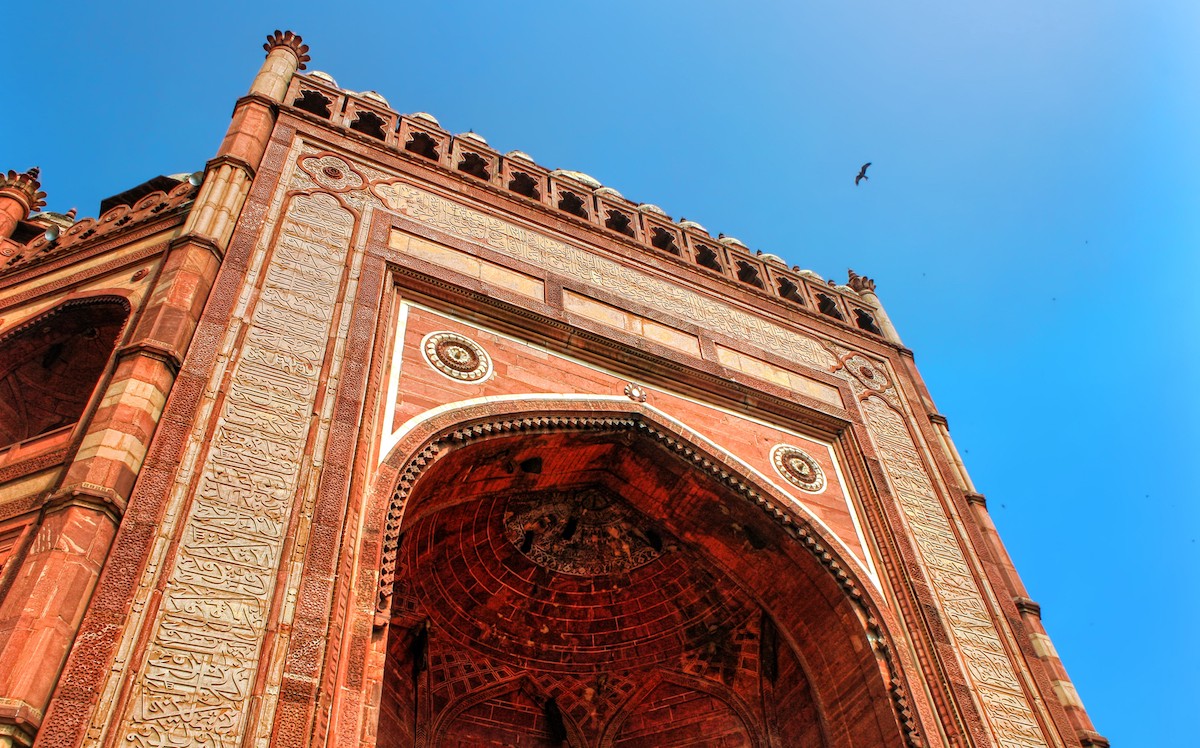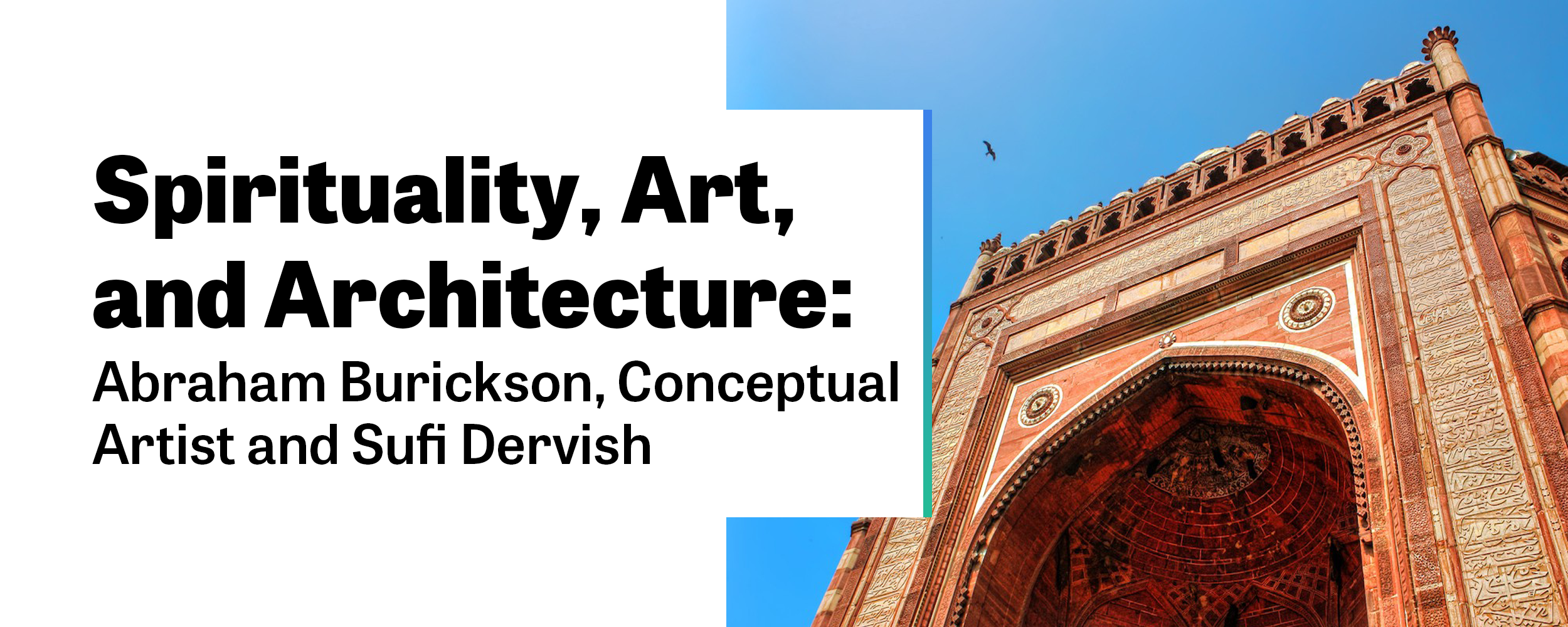
Writing and Interview by Lydia Laurenson
Published November 11, 2019
Photo: The Buland Darwaza in Agra. Credit to Daniel Mennerich, via Flickr Creative Commons
“I don’t like to use the word God because it closes the door of the question for me.”
Years ago, I met Abraham Burickson at a gathering for “adventure designers” — people who love to create intense and transformative experiences for others. Since then, I’ve fallen in love with his boundary-pushing art, and he and I have supported each others' projects in various ways (indeed, he's one of our Catalysts at The New Modality — read his Catalyst profile here).
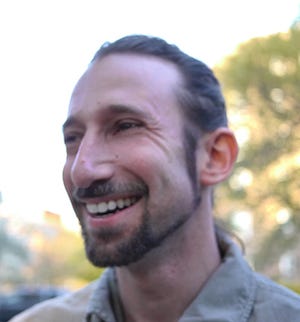
Abraham Burickson. Photo by Ariel Abrahams
Burickson is an architect and an award-winning poet. He’s also the artistic director of Odyssey Works, a conceptual art group that creates detailed, tailored performances for an audience of one person. Burickson and his team study each person extensively in order to deliver a months-long transformative adventure, specifically for that person.
After we'd been friends for a while, I had a major spiritual experience that re-ordered my cosmology. When I told him about it, I learned that he’s spent years studying various traditions — and his spiritual work had a huge impact on both his artistic and architectual work.
As someone who loves Burickson's art, and who was exploring my own spiritual side, I had to learn more about how he thinks of spirituality. The following interview took place in early 2017.
LYDIA LAURENSON: You've said that in your twenties, did a lot of traveling and study related to spirituality. Can you tell more about what you did?
ABRAHAM BURICKSON: I would say the bigger journey that I took was into Islam and Sufism. In 1995, I was studying at Cornell, and I dropped out because I had been to see the whirling dervishes. They came around to New York to St. John the Divine Cathedral, up in Harlem, and something rang a bell.
I realized: Oh, there is a physical enactment, a posture, of search. That made perfect sense to me. I felt it — looked at the dervishes and felt it. I thought: How do I do that? And I thought it would be easy, but it wasn’t.
“I looked at the dervishes... and thought: How do I do that? And I thought it would be easy, but it wasn’t.”
They weren’t actually working with the whirling in New York — they were whirling in Turkey. So later in 1995, I showed up in Istanbul with a letter of introduction in Turkish, a language I didn’t read and could barely speak. I just walked into a smoke-filled room and gave the sheikh this letter.
I lived in a hostel and then in the orthodox religious part of Istanbul for about two and a half months. Then I came back to the States and studied with the Mevlevis for another year, while going back to school.
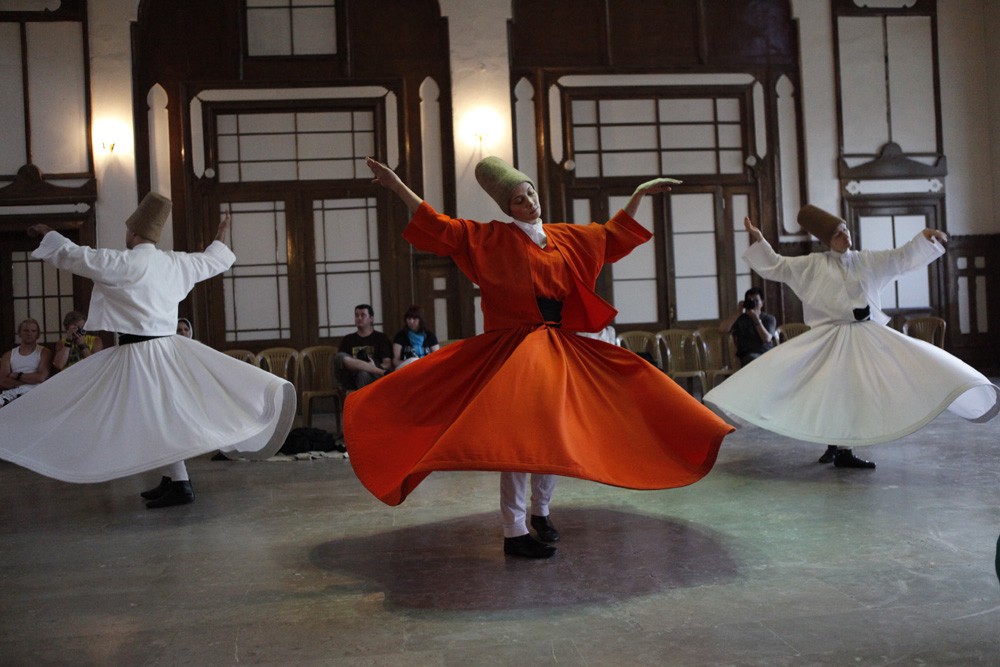
Whirling Dervishes (Hodjapasha). Photo by Ishan Kosla, via Flickr Creative Commons
LYDIA: Were you raised in a religion?
ABRAHAM: Judaism. Later in my travels, I came back to Judaism — spent some time with Sephardic rabbis in the north of Israel. I’d always been very turned off by Judaism and I didn’t want to come back to it. But as an adult, I developed a new relationship with these questions.
I suppose lots of people end up feeling alienated from the religion that they’re raised in, and speak about the hypocrisy of it. The thing that drove me most crazy about Judaism was all the talk about questioning, the talk about investigation, the talk about being curious — and how little it actually manifested in practice. I kept feeling like doors were closed.
I mean, I had these huge questions, like: What is with this religion where you’re just following rules all the time? How is that spiritual practice? It’s like a legalistic approach to spirituality. It seems crazy to me.
LYDIA: Did you have a visceral, personal, felt sense of spirituality as a child?
ABRAHAM: I had this absolute sense that the world as I knew it was a small subset of the world as it was. I had one experience as a child, riding down a hill on my bicycle, which paralleled later experiences I had during the whirling.
These experiences are described in incredibly flowery language in the books about whirling, but they’re actually impossible to describe, right? Partly because there is no language for something you feel when you don’t have your language right there with you. And partly because even if I can describe it perfectly — even to myself — if you’re not in that state at the time, it doesn’t mean anything.
Also, when I was a teenager, I used to take trips with this old lady. Me and a group of other 14 year olds. She had this incredible attention, her very presence was radiant, and she had an incredible intelligence. She taught us to meditate, and she brought us to Mayan temple ruins in the south of Mexico.
She walked us in without telling us history or reading to us the didactics, without giving us pictures of the reconstruction as imagined by archaeologists. She just walked us in and she said, “People used to live here and this is the way they saw the world. These buildings represented their understanding of what is sacred.”
It was mind-blowing.
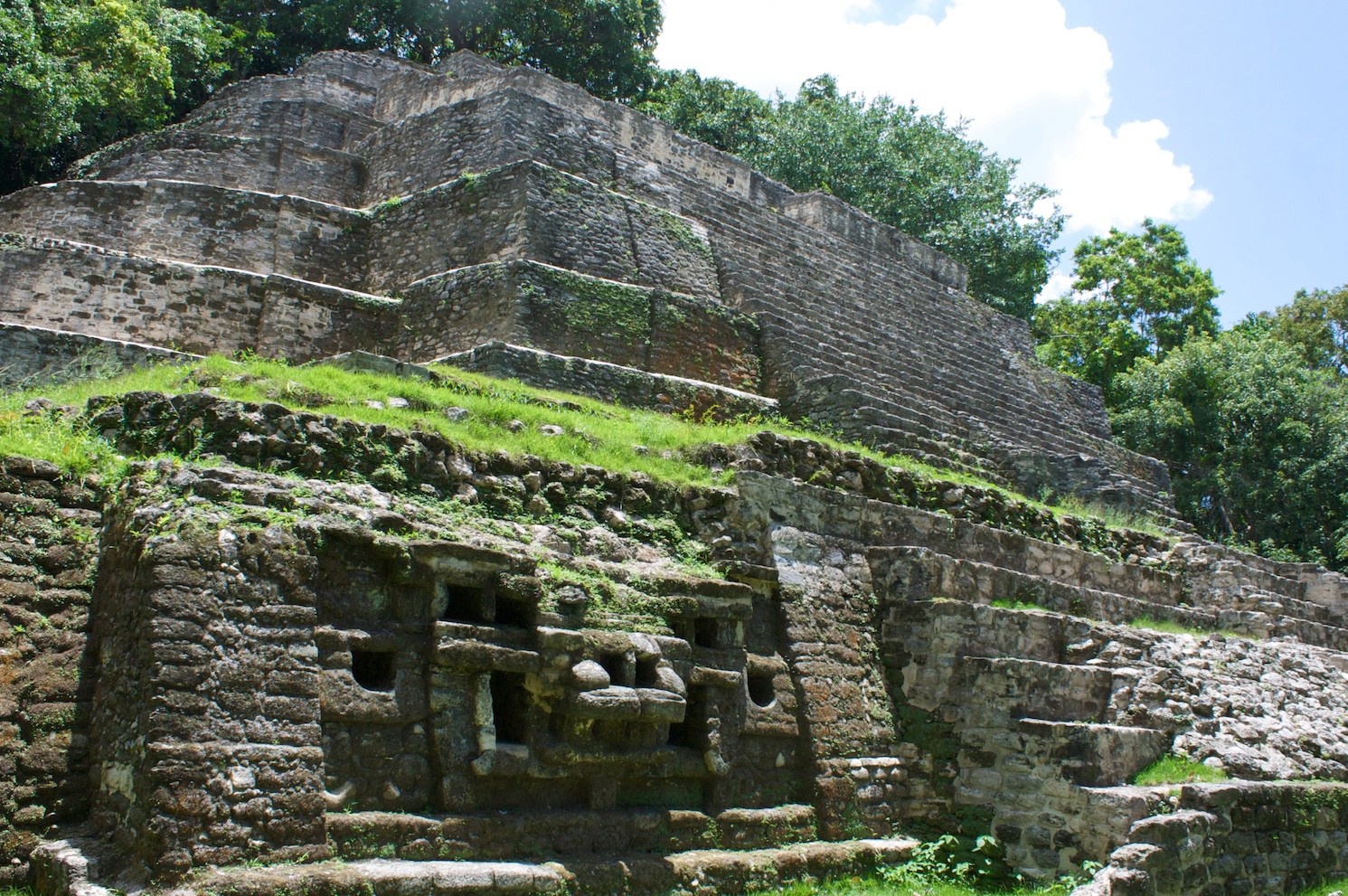
Mayan temple. Photo by Rachel Smith, via Flickr Creative Commons
Years later, I went back to that place, went in the front door. I went the normal way and I read the book, the tour guide, and I looked at the maps and I eavesdropped on a walking tour. No wonder was there. Nothing was changed.
It affirmed my understanding of the limits of the world as I knew it.
Whereas when she brought us, she set me on a path that even in my art today, I’m still trying to follow. That was a seed. And that seed grew into this question: How do I not know the limits of my world? How do I not know?
“Where are my assumptions about what is real and what is imaginary? What are my assumptions about spirituality and God? Where am I closing myself down to these possibilities?”
Where are my assumptions about what is real and what is imaginary? What are my assumptions about spirituality and God? Where am I closing myself down to these possibilities?
To me, the obvious response to that question was, I have to get outside of my ordinary worldview. I thought: What are the worldviews that are strangest to me? And I thought, well, people living in the Amazon jungle probably have a worldview pretty different from mine, and nomadic peoples.
So after my journey in Turkey with the dervishes, I also went and visited with these groups called the Yuruks up on the hillside. And they were very foreign. I remember walking up the hill and thinking: These people have never been to a juggling convention, they probably don’t even know a juggling convention is. Why do I even know what a juggling convention is?
Then later I went to live in the Amazon, with people who believed this isn’t the real world and the only way into the real world is through hallucinogens. That the moving water is where God lives. That monkeys have souls just like people, and monkeys can be related to as one can relate to people, and can be warred with as one wars with people.
Just to be immersed in those things: That shook something loose in me. There’s a kinesthetic comprehension of a different limitation to life. I could tell myself these things, but to embody a different way of being there… is different.
After all these travels, I came back home. I started writing down all of the things I believed and started crossing them out. I found holes in them until I had nothing. I had nothing.
And I got really depressed.
LYDIA: I know what you mean. I made a list like that last year. But tell me more about what you learned from these religious and cultural structures.
ABRAHAM: There is so much powerful work with religious traditions. I went back to the dervish lodge in Turkey two years ago, and I went back a couple months ago to the lodge in New York. The feeling was still there — it still had that resonant effect.
"In a way, religion is the materialization of a metaphysical situation."
In a way, religion is the materialization of a metaphysical situation. Like, it’s not just a funky game that you have to go to Mecca [as part of the hajj, the journey that religious Muslims make]. There’s something very powerful about having to enact in a physical way what happens on the spiritual plane.
This is why I became an architect: Because I went into these buildings, these mosques. And something happened that was indescribable.
As I studied, I started to see. A mosque is oriented towards spiritual geography of the earth. And you know it points towards Mecca. What is Mecca? Like the umbilical cord between the Earth and the heavens. It is where God enters.
Religious architecture encodes a worldview. You have these four sides to a mosque, pointing in the four cardinal directions. And then the dome with the Oneness, the point at the center, the unseeable thing. The way you are underneath that dome is in relationship to something higher, above.
You ask: How do I embody that in my life? How can I be related to something of another level?
In that conceptual structure, God’s not here, and then God comes, and there’s one spot where it happens. It sounds like a game — but if you materialize that game, you materialize that search, it’s more than just symbolic, it’s an embodied symbolism.
And in order for that to be really effective you have to really be in it. You can’t just pretend that you think that’s where God enters the earth, because then it’s not real. It’s this weird catch-22.
But I could never get over the emotional leap, the belief leap that was required, for me to participate in the religion. It’s not just the rules. The belief. To follow that path, you have to say this book is true. And you have to believe — you have to have faith in a certain construction of the universe.
It doesn’t work without faith. I tried and I couldn’t go there. I had no faith in belief. It came from my mind, and my mind could tear it apart.
LYDIA: How did you ultimately find a way to relate to spirituality?
ABRAHAM: When I was down in Ecuador I had started talking to a very large man who had a chocolate factory and was a student of the spiritual teacher G. I. Gurdjieff. He suggested that there could be a spirituality that was based on rigorous investigation with all one’s senses rather than belief.
Emotionally, we can understand things about spirituality. But intellectually, I get into a logical loop that’s all about taking things apart but not really about putting things together.
"Emotionally, we can understand things about spirituality. But intellectually, I get into a logical loop that’s all about taking things apart but not really about putting things together."
There’s a way to study involving different intelligences — involving emotional intelligence, involving the physical intelligence, and being engaged in a kind of continual spiritual research. This was about just trying to inhabit myself, anywhere I went. Because it seemed like that was the only place I could reliably start.
What is it just to inhabit myself?
This man with the chocolate factory, he said: “What if you just ventured into the ‘I don’t know’ ? What if you really had faith in your ‘I don’t know’ ?”
I was like, “Well sure, I don’t know what God is.”
“No,” he said, “no, can you not know what you are? Can you not know what it is that’s you? Are you your personality that keeps changing? Or your reactions, or even your points of view?”
So he gave me this, which was a question-based approach, and meditation and practice for attention, consciousness and action.
But I feel the loss of dervish life. I feel the power of the emotional quality of devotion and annihilation, giving yourself over completely. There’s an absolute trust in your sheikh.
LYDIA: Beautiful. Okay, one more question. You mentioned God. What’s your conception of God?
ABRAHAM: I have such a hard time with that. God. I remember my father asking me, “Do you believe in God?”
I was just like, What are you talking about? It’s like you just asked me if I believe there is a place where there are rabbits at war with dogs. It seemed so... random.
I haven’t been able to come at it from a non-experiential point of view. But along the way I’ve had these experiences of other energies. It’s almost like what Jeanne de Salzmann calls “a look from above:” A sense that I, here, am not an independent unit and self-contained ego.
Whatever is vital in my consciousness is related to something totally other. And that relationship is not God but is… an open gateway, to that other level of possibility, which might involve something along those lines. Do you know what I mean?
The dervishes say that when you do the whirling, if you get your prayers right and your spin is just right, then you ascend to the doorstep of God, past the seven veils. Normally, in that tradition, if you want to go to God, you pass these seven veils, but through the whirling you take a shortcut.
That’s what they say.
My experience of whirling didn’t bring me to a place where there was some anthropomorphized consciousness with an intention for me. But it brought me as close as I could say into a relationship with an incomprehensible other energy and consciousness. I have no doubt that this experience was related to the experience they’re talking about. But they have a much more elaborate description of what that meant than I did. I still don’t.
So I don’t like to use the word God because I feel it closes the door of the question for me.
Transparency Notes
This interview was conducted and edited by Lydia Laurenson. (Read her NewMo profile here.) The interview was not reviewed by an external fact-checker. For more about our transparency process, check out our page about truth and transparency at The New Modality.

